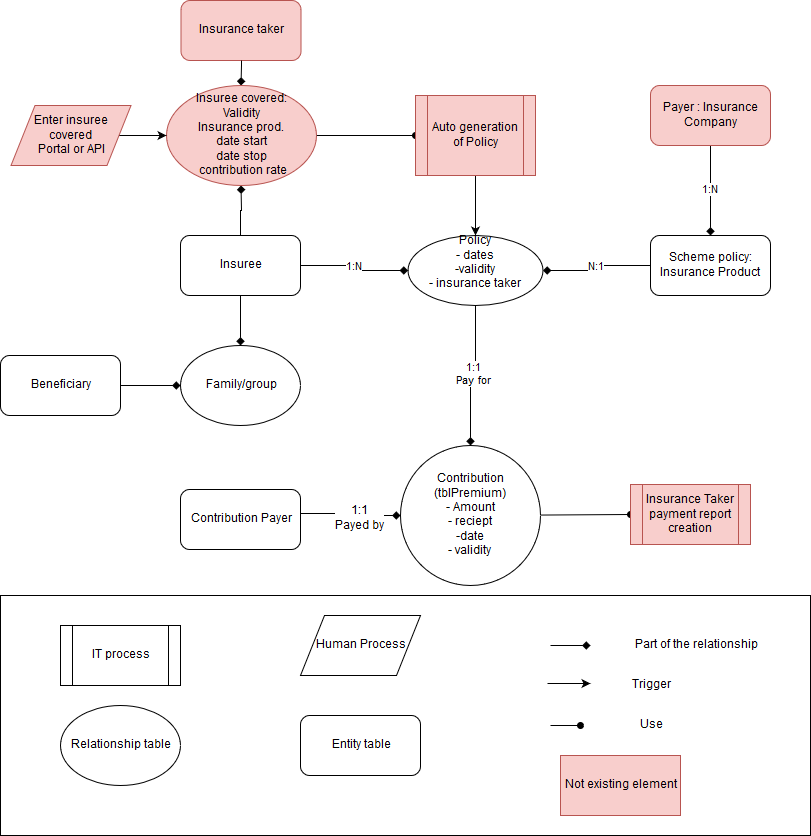This page is a space to discuss and define the business process and required functionalities to cover formal sector members of a health financing scheme.
Moved this to Nepali Requirements requirementsOpenIMIS functional analysis_needs for the future_MS_SB_ND_070918.docx |
openIMIS's current functionality for membership enrolment is geared towards the informal sector with enrollment agents going door to door to collect beneficiary data and contributions from individuals/families. This functional design is not efficient if the scheme operator wishes to expand coverage to employers and a large number of employees and their families need to be enrolled at once. For such scenarios, openIMIS would need functionality to consume large amounts of beneficiary data (ideally with synchronous interoperability with human resource IT systems) at once and assign respective policies to the individual/family, while also keeping track of the contribution requirements and the corresponding incoming payments for those policies.
Informal Sector Definition (JLN)
|
Households are ACTIVELY approached to make them aware of the SHI availability
The most common ways are:
- Door to door enrollment
- Through health facilities (e.g. at a specific day)
- At various social gatherings
Households are enrolled via an enrollment form and via capturing their picture through smartphone technology.
Forms and membership identity card with QR code are pre-printed and given to the SHI enrollment assistant prior to the enrollment procedure.
Enrollment should be done also without the need of pre-printed enrollment forms. The SHI Identification Number and the ID Card should be given directly through the System
Individual membership accounts (this also relates the re-structuring needs for the user interface: The user interface needs to show the family relations in a structured way. The user should see the head of the household and the related family members on one screen. The user must see immediately if the breadwinner and the family is covered via a voluntary scheme or as part of a formal sector coverage). This is an UI question.
Employers register their worker at the enterprise at the day when they are supposed to start working - based on a work contract (usually, the labor law foresees this). The following scenarios are found in some schemes/countries:
The employer registers each worker via a standardized (electronic) form and sends this form to the health insurance fund
The employers send a list of all new workers via Excel list to the health insurance fund
The employers provide information on all new workers via an online interface, designed/provided by the health insurance fund
The employers use different data formats for providing the information but stick on a pre-defined API, given by the SHI Operator
Workers have to visit a SHI Operator Branch office and register themselves by showing the work contract and ID card
The above-mentioned scenarios usually happen once a month.
Note: For the formal sector enrollment, it’s crucial to understand the difference between initial enrollments (e.g. the Government decides to include formal sector workers as a new target group for SHI) and ongoing enrollments throughout the year.
A family member who was previously insured via the informal sector scheme (family coverage) might start a job in the formal sector and now need to pay own contributions. A family member who stops working for the formal sector might need coverage via the informal sector scheme again.
A warning needs to be triggered if a family member is “too old” for family coverage (e.g. < 18 years). It’s a strong requirement for the formal sector. The admin panel should allow setting an “age ceiling”.
Coverage of family members should be related to specific criteria (e.g. marriage, age). The software should allow the definition of these criteria.
Pay attention to this!Where are the family members insured? How can we get information about family members in countries where the postal system is weak and we have limited access in the countryside? Identities for family members who receive free coverage under the person so works in the formal sector need to be checked carefully during enrollment. The names of the family members who get free coverage can’t get changed for a certain period of time (e.g. 1 year) anymore. This is necessary to avoid that “fake family members” will get coverage without having a “paying” household head, working in the formal sector. |
The issues around new functionality regarding the formal sector has been documented in the openIMIS software issue queue: https://openimis.atlassian.net/browse/OSD-28
The initial proposal by Jiri Nemec, further commented by Michael Stahl: RfC_XX_support_of_formal sector_20180715_SB_MS.docx
Updated with comments from Patrick Delcroix: RfC_XX_support_of_formal sector_20190701_PD.docx
Use a generic name for
policy holder: actor taking the insurance (e.g. an employer)
Insuree: Person who has an insurance policy on his name
Beneficiary: Person covered by an insurance policy (on its name or not)
Contribution payer: the actor that pays the policies contribution/ premium
Programmatic approach:
Insuree covered (e:g: employee) by an insurance taker are coming for an API (enter in APP/portal/ third party app)
Policy is generated from the "insuree covered" on a recurrent basis (doesn't have to generate all policies every time, only the new/renew one), the contribution rate will help to define the "price" of the policy (parameter that should be used in the calculation defined on the insurance product level )
Policy Payment report per insurance taker

The source file for this drawing (Formal sector.drawio) can be read and edited on https://www.draw.io/.